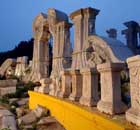About Haiti
Why Haiti keeps getting hammered by disasters
(Agencies)
Updated: 2010-01-14 20:57
 |
Large Medium Small |
When it comes to natural disasters, Haiti seems to have a bull's-eye on it. That's because of a killer combination of geography, poverty, social problems, slipshod building standards and bad luck, experts say.
The list of catastrophes is mind-numbing: This week's devastating earthquake. Four tropical storms or hurricanes that killed about 800 people in 2008. Killer storms in 2005 and 2004. Floods in 2007, 2006, 2003 (twice) and 2002. And that's just the 21st Century run-down.
"If you want to put the worst case scenario together in the Western hemisphere (for disasters), it's Haiti," said Richard Olson, a professor at Florida International University who directs the Disaster Risk Reduction in the Americas project.
"There's a whole bunch of things working against Haiti. One is the hurricane track. The second is tectonics. Then you have the environmental degradation and the poverty," he said.
This is the 15th disaster since 2001 in which the US Agency for International Development has sent money and help to Haiti. Some 3,000 people have been killed and millions of people displaced in the disasters that preceded this week's earthquake. Since the turn of this century the US has sent more than $16 million in disaster aid to Haiti.
While the causes of individual disasters are natural, more than anything what makes Haiti a constant site of catastrophe is its heart-tugging social ills, disaster experts say. It starts with poverty, includes deforestation, unstable governments, poor building standards, low literacy rates and then comes back to poverty.
This week's devastating quake comes as Haiti is still trying to recover from 2008, when it was hit four times by tropical storms and hurricanes, said Kathleen Tierney, director of the University of Colorado's Natural Hazard Center.
And while there is bad luck involved, former top FEMA official Mark Merritt, president of the disaster consulting firm James Lee Witt Associates, says, "It's an economic issue. It's one of those things that feeds on each other."
Every factor that disaster experts look for in terms of vulnerability is the worst it can be for Haiti, said Dennis Mileti, a seismic safety commissioner for the state of California and author of the book "Disasters by Design."
Add to that the high population density in the capital, many of them migrants from the countryside who live in shantytowns scattered throughout Port-au-Prince.
"It doesn't get any worse," said Mileti, a retired University of Colorado professor. "I fear this may go down in history as the largest disaster ever, or pretty close to it."
For this to be the deadliest quake on record, the death toll will have to top the 2004 Asian tsunami that killed more than 227,000, according to the US Geological Survey.
While nobody knows the death toll in Haiti, a leading senator, Youri Latortue, told The Associated Press that as many as 500,000 could be dead.
"Whether it comes in as No. 1, No. 2 or No. 3, only time will tell," Mileti said. "This is a major cataclysm."
Vulnerability to natural disasters is almost a direct function of poverty, said Debarati Guha Sapir, director of the World Health Organization's Centre for Research on the Epidemiology of Disasters.
"Impacts are not natural nor is there a divine hand or ill fate," Sapir said. "People will also die now of lack of follow-up medical care. In other words, those who survived the quake may not survive for long due to the lack of adequate medical care."
University of South Carolina's Susan Cutter, who maps out social vulnerability to disaster by county in the United States, said Haiti's poverty makes smaller disasters there worse.
"It's because they're so vulnerable, any event tips the balance," said Cutter, director of the school's Hazards and Vulnerability Research Institute. "They don't have the kind of resiliency that other nations have. It doesn't take much to tip the balance."
A magnitude 7 earthquake is devastating wherever it hits, Cutter said. But it's even worse in a place like Haiti.
One problem is the poor quality of buildings, Merritt said. Haiti doesn't have building codes and even if it did, people who make on average $2 a day can't afford to build something that can withstand earthquakes and hurricanes, he said. Poverty often is a major reason for poor infrastructure, Tierney said.
Then there's the deforestation that leads to mudslides and flooding because Haiti leads the hemisphere in tree-clearing, Merritt and others said. That causes erosion which worsens flooding. The trees are cut down mostly for cooking because of the poverty, Merritt said.
Another problem is the inability to prepare for and cope with disaster, said Merritt, who last fall started work to help train Haitians to prepare for disasters, including creating emergency response teams in a country that only has a couple of fire stations. It involved Haiti's small disaster bureau, the United Nations, Red Cross and other relief agencies and governments. The training manuals were still being translated from English to Creole when the earthquake hit, he said.
"If you look at neighboring Cuba, they have a very good emergency management infrastructure," Tierney said. "That's partly because of the way they organize the country from the block upward."
Another issue is that Haiti has been hurricane focused because quakes have been so rare in its history.
Until about a decade ago, scientists thought the north coast of Hispaniola was more prone to earthquakes. But work by Tim Dixon of the University of Miami found the southern fault zone, where Tuesday's quake occurred, was equally likely to produce temblors.
Scientists have known about the seismic threat for a while now, but Dixon said that doesn't help the Haitian government, which lacks the resources to quake-proof buildings and structures.
"This was not that huge of an earthquake, but there's been a lot of damage," he said. "It's the tragedy of a natural disaster superimposed on a poor country."
Haiti shares the island with the relatively richer Dominican Republic, which provides a good contrast when it comes to catastrophes, experts said.
Buildings in the Dominican Republic are stronger and withstand disaster better, Merritt said. Partly that's because it is a richer country with a more stable government.
The damage to Haiti is so devastating, so extensive that it offers a sense of hope in rebuilding, the experts said. Past disasters, including Hurricane Katrina, show that it is easier to put up new buildings than rebuild damaged ones, which is one reason why the wiped-clear Mississippi coast came back faster than New Orleans, Merritt said.
After the killer 1976 earthquake in Guatemala, houses were rebuilt with less vulnerable, lighter roofs and the entire region was designed to be less disaster prone, FIU's Olson said.
"Catastrophic disasters open a window of opportunity to fundamentally change how cities are rebuilt," Olson said. "If it's rebuilt in the same fashion (as it is now), our children are going to have this same conversation."











